Leadership and Management Report: Tesco Case Study Analysis
VerifiedAdded on 2023/01/06
|17
|4846
|27
Report
AI Summary
This report provides an in-depth analysis of leadership and management principles, using Tesco as a case study. It begins by defining and comparing the roles and characteristics of leaders and managers, differentiating their functions through the application of various theories and concepts. The report then examines how these roles apply in different situational contexts, such as new product launches and conflict management, while also applying situational, systems, and contingency leadership theories. It explores key approaches to operations management, emphasizing the importance of efficiency in achieving business objectives. Finally, the report assesses the impact of factors within the business environment on operational management and decision-making, evaluating their effects on the business and the wider community. The report utilizes Tesco as a practical example throughout its analysis, making it a valuable resource for students studying leadership and management.
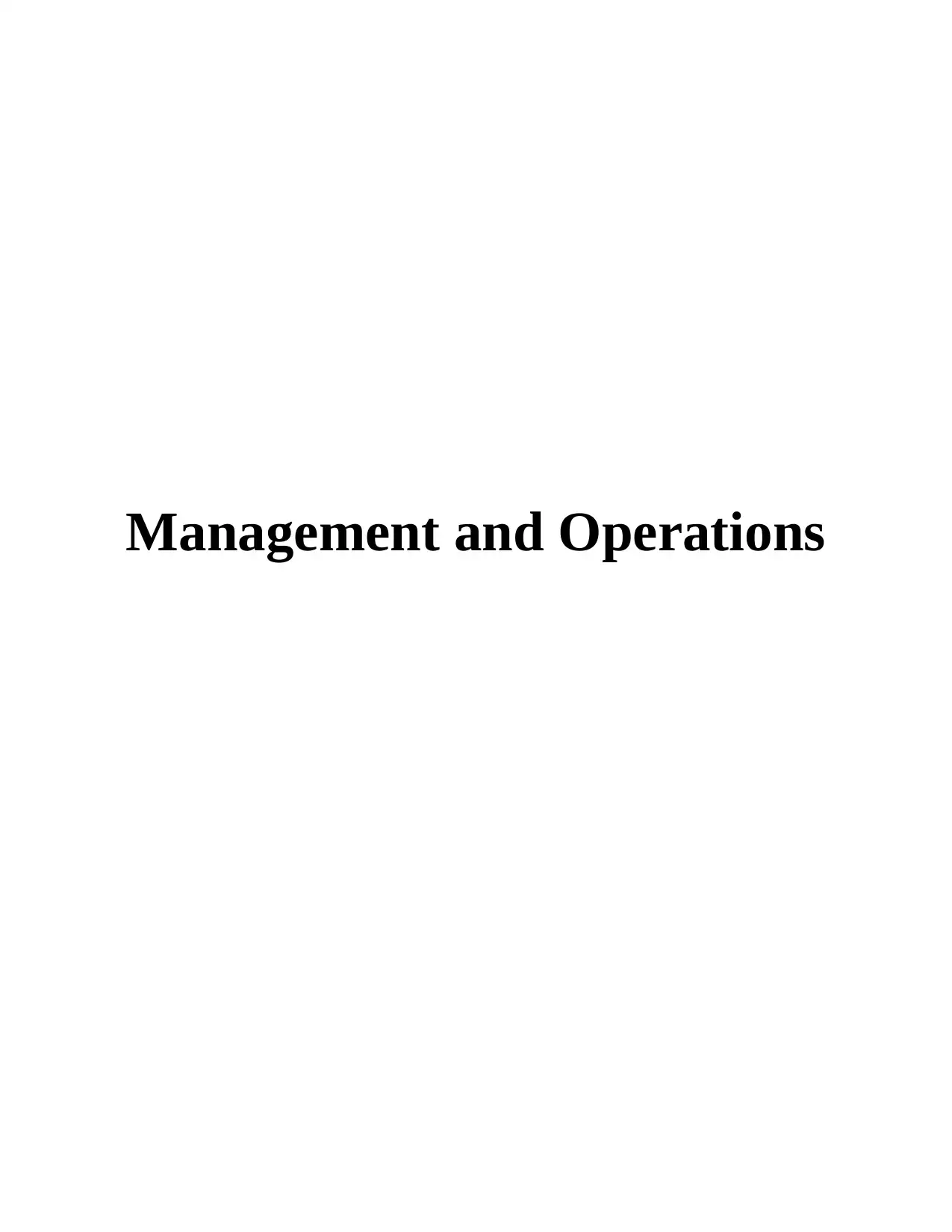
Management and Operations
Paraphrase This Document
Need a fresh take? Get an instant paraphrase of this document with our AI Paraphraser
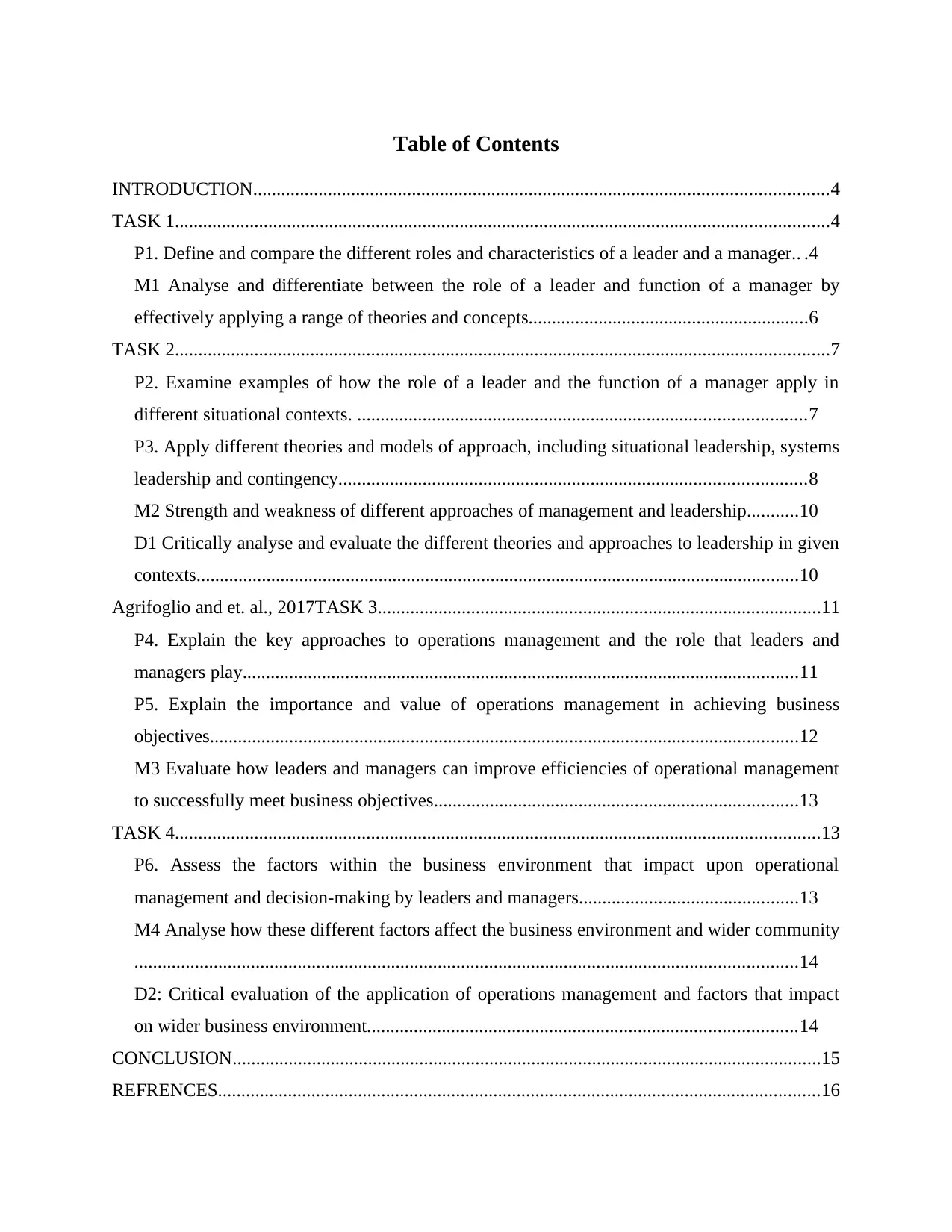
Table of Contents
INTRODUCTION...........................................................................................................................4
TASK 1............................................................................................................................................4
P1. Define and compare the different roles and characteristics of a leader and a manager.. .4
M1 Analyse and differentiate between the role of a leader and function of a manager by
effectively applying a range of theories and concepts............................................................6
TASK 2............................................................................................................................................7
P2. Examine examples of how the role of a leader and the function of a manager apply in
different situational contexts. ................................................................................................7
P3. Apply different theories and models of approach, including situational leadership, systems
leadership and contingency....................................................................................................8
M2 Strength and weakness of different approaches of management and leadership...........10
D1 Critically analyse and evaluate the different theories and approaches to leadership in given
contexts.................................................................................................................................10
Agrifoglio and et. al., 2017TASK 3...............................................................................................11
P4. Explain the key approaches to operations management and the role that leaders and
managers play.......................................................................................................................11
P5. Explain the importance and value of operations management in achieving business
objectives..............................................................................................................................12
M3 Evaluate how leaders and managers can improve efficiencies of operational management
to successfully meet business objectives..............................................................................13
TASK 4..........................................................................................................................................13
P6. Assess the factors within the business environment that impact upon operational
management and decision-making by leaders and managers...............................................13
M4 Analyse how these different factors affect the business environment and wider community
..............................................................................................................................................14
D2: Critical evaluation of the application of operations management and factors that impact
on wider business environment............................................................................................14
CONCLUSION..............................................................................................................................15
REFRENCES.................................................................................................................................16
INTRODUCTION...........................................................................................................................4
TASK 1............................................................................................................................................4
P1. Define and compare the different roles and characteristics of a leader and a manager.. .4
M1 Analyse and differentiate between the role of a leader and function of a manager by
effectively applying a range of theories and concepts............................................................6
TASK 2............................................................................................................................................7
P2. Examine examples of how the role of a leader and the function of a manager apply in
different situational contexts. ................................................................................................7
P3. Apply different theories and models of approach, including situational leadership, systems
leadership and contingency....................................................................................................8
M2 Strength and weakness of different approaches of management and leadership...........10
D1 Critically analyse and evaluate the different theories and approaches to leadership in given
contexts.................................................................................................................................10
Agrifoglio and et. al., 2017TASK 3...............................................................................................11
P4. Explain the key approaches to operations management and the role that leaders and
managers play.......................................................................................................................11
P5. Explain the importance and value of operations management in achieving business
objectives..............................................................................................................................12
M3 Evaluate how leaders and managers can improve efficiencies of operational management
to successfully meet business objectives..............................................................................13
TASK 4..........................................................................................................................................13
P6. Assess the factors within the business environment that impact upon operational
management and decision-making by leaders and managers...............................................13
M4 Analyse how these different factors affect the business environment and wider community
..............................................................................................................................................14
D2: Critical evaluation of the application of operations management and factors that impact
on wider business environment............................................................................................14
CONCLUSION..............................................................................................................................15
REFRENCES.................................................................................................................................16

⊘ This is a preview!⊘
Do you want full access?
Subscribe today to unlock all pages.

Trusted by 1+ million students worldwide
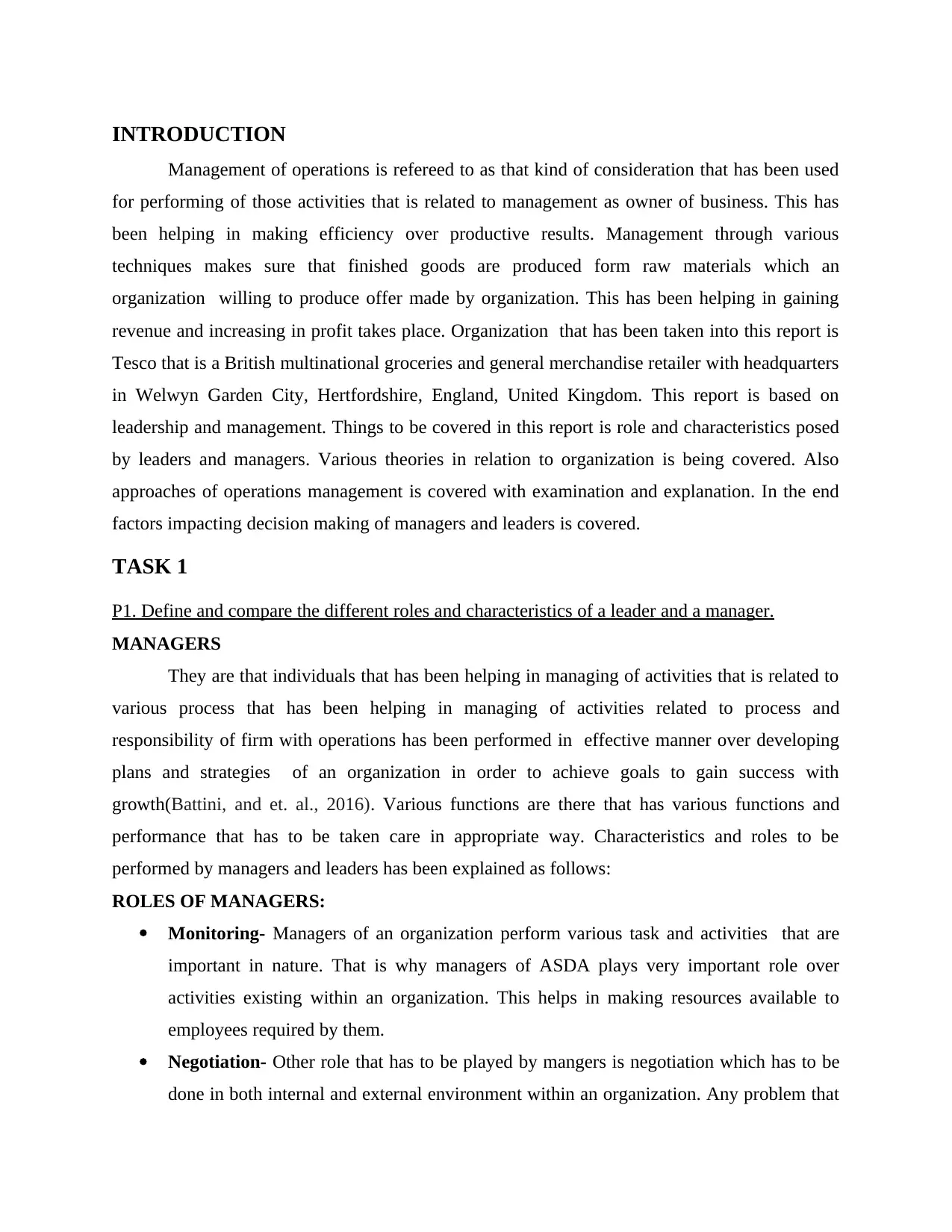
INTRODUCTION
Management of operations is refereed to as that kind of consideration that has been used
for performing of those activities that is related to management as owner of business. This has
been helping in making efficiency over productive results. Management through various
techniques makes sure that finished goods are produced form raw materials which an
organization willing to produce offer made by organization. This has been helping in gaining
revenue and increasing in profit takes place. Organization that has been taken into this report is
Tesco that is a British multinational groceries and general merchandise retailer with headquarters
in Welwyn Garden City, Hertfordshire, England, United Kingdom. This report is based on
leadership and management. Things to be covered in this report is role and characteristics posed
by leaders and managers. Various theories in relation to organization is being covered. Also
approaches of operations management is covered with examination and explanation. In the end
factors impacting decision making of managers and leaders is covered.
TASK 1
P1. Define and compare the different roles and characteristics of a leader and a manager.
MANAGERS
They are that individuals that has been helping in managing of activities that is related to
various process that has been helping in managing of activities related to process and
responsibility of firm with operations has been performed in effective manner over developing
plans and strategies of an organization in order to achieve goals to gain success with
growth(Battini, and et. al., 2016). Various functions are there that has various functions and
performance that has to be taken care in appropriate way. Characteristics and roles to be
performed by managers and leaders has been explained as follows:
ROLES OF MANAGERS:
Monitoring- Managers of an organization perform various task and activities that are
important in nature. That is why managers of ASDA plays very important role over
activities existing within an organization. This helps in making resources available to
employees required by them.
Negotiation- Other role that has to be played by mangers is negotiation which has to be
done in both internal and external environment within an organization. Any problem that
Management of operations is refereed to as that kind of consideration that has been used
for performing of those activities that is related to management as owner of business. This has
been helping in making efficiency over productive results. Management through various
techniques makes sure that finished goods are produced form raw materials which an
organization willing to produce offer made by organization. This has been helping in gaining
revenue and increasing in profit takes place. Organization that has been taken into this report is
Tesco that is a British multinational groceries and general merchandise retailer with headquarters
in Welwyn Garden City, Hertfordshire, England, United Kingdom. This report is based on
leadership and management. Things to be covered in this report is role and characteristics posed
by leaders and managers. Various theories in relation to organization is being covered. Also
approaches of operations management is covered with examination and explanation. In the end
factors impacting decision making of managers and leaders is covered.
TASK 1
P1. Define and compare the different roles and characteristics of a leader and a manager.
MANAGERS
They are that individuals that has been helping in managing of activities that is related to
various process that has been helping in managing of activities related to process and
responsibility of firm with operations has been performed in effective manner over developing
plans and strategies of an organization in order to achieve goals to gain success with
growth(Battini, and et. al., 2016). Various functions are there that has various functions and
performance that has to be taken care in appropriate way. Characteristics and roles to be
performed by managers and leaders has been explained as follows:
ROLES OF MANAGERS:
Monitoring- Managers of an organization perform various task and activities that are
important in nature. That is why managers of ASDA plays very important role over
activities existing within an organization. This helps in making resources available to
employees required by them.
Negotiation- Other role that has to be played by mangers is negotiation which has to be
done in both internal and external environment within an organization. Any problem that
Paraphrase This Document
Need a fresh take? Get an instant paraphrase of this document with our AI Paraphraser
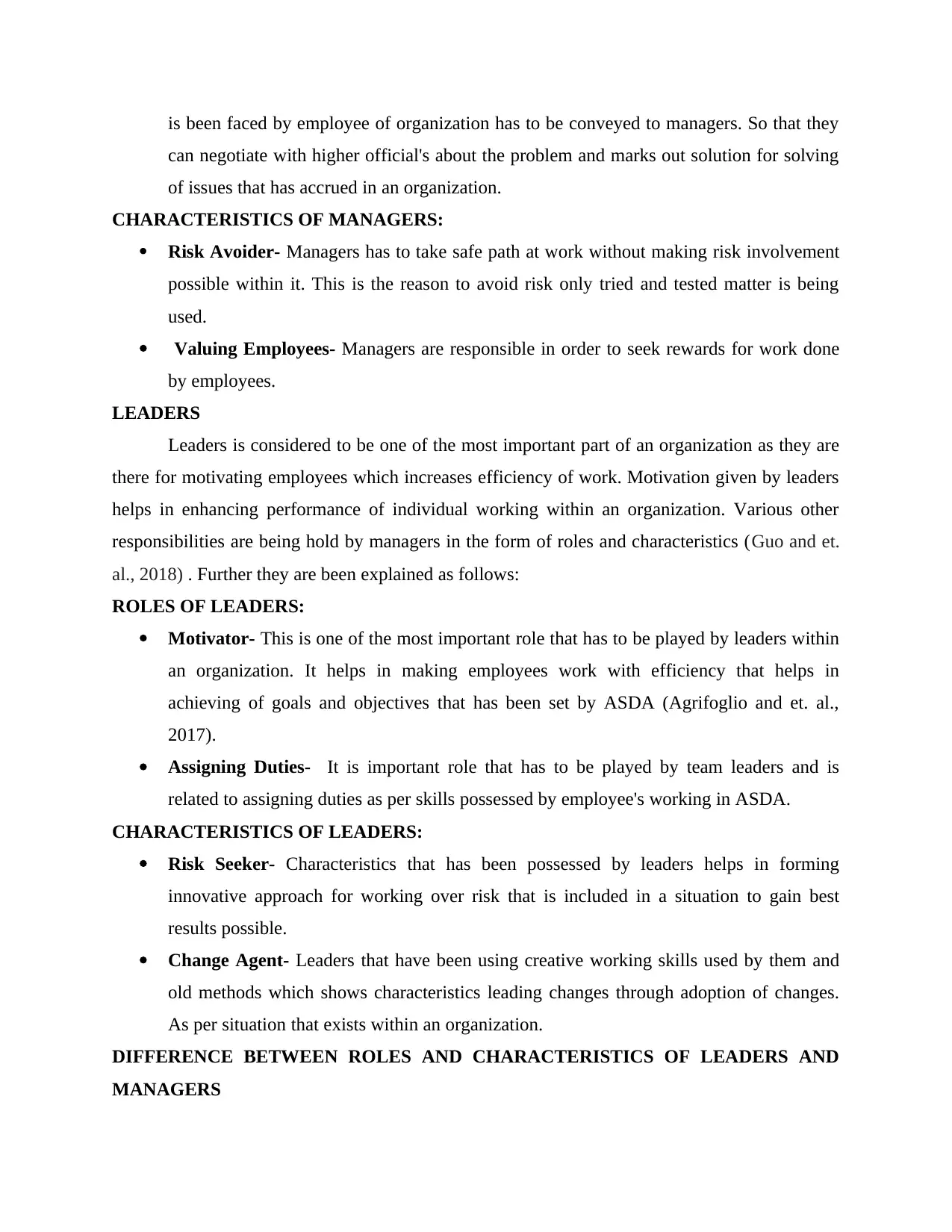
is been faced by employee of organization has to be conveyed to managers. So that they
can negotiate with higher official's about the problem and marks out solution for solving
of issues that has accrued in an organization.
CHARACTERISTICS OF MANAGERS:
Risk Avoider- Managers has to take safe path at work without making risk involvement
possible within it. This is the reason to avoid risk only tried and tested matter is being
used.
Valuing Employees- Managers are responsible in order to seek rewards for work done
by employees.
LEADERS
Leaders is considered to be one of the most important part of an organization as they are
there for motivating employees which increases efficiency of work. Motivation given by leaders
helps in enhancing performance of individual working within an organization. Various other
responsibilities are being hold by managers in the form of roles and characteristics (Guo and et.
al., 2018) . Further they are been explained as follows:
ROLES OF LEADERS:
Motivator- This is one of the most important role that has to be played by leaders within
an organization. It helps in making employees work with efficiency that helps in
achieving of goals and objectives that has been set by ASDA (Agrifoglio and et. al.,
2017).
Assigning Duties- It is important role that has to be played by team leaders and is
related to assigning duties as per skills possessed by employee's working in ASDA.
CHARACTERISTICS OF LEADERS:
Risk Seeker- Characteristics that has been possessed by leaders helps in forming
innovative approach for working over risk that is included in a situation to gain best
results possible.
Change Agent- Leaders that have been using creative working skills used by them and
old methods which shows characteristics leading changes through adoption of changes.
As per situation that exists within an organization.
DIFFERENCE BETWEEN ROLES AND CHARACTERISTICS OF LEADERS AND
MANAGERS
can negotiate with higher official's about the problem and marks out solution for solving
of issues that has accrued in an organization.
CHARACTERISTICS OF MANAGERS:
Risk Avoider- Managers has to take safe path at work without making risk involvement
possible within it. This is the reason to avoid risk only tried and tested matter is being
used.
Valuing Employees- Managers are responsible in order to seek rewards for work done
by employees.
LEADERS
Leaders is considered to be one of the most important part of an organization as they are
there for motivating employees which increases efficiency of work. Motivation given by leaders
helps in enhancing performance of individual working within an organization. Various other
responsibilities are being hold by managers in the form of roles and characteristics (Guo and et.
al., 2018) . Further they are been explained as follows:
ROLES OF LEADERS:
Motivator- This is one of the most important role that has to be played by leaders within
an organization. It helps in making employees work with efficiency that helps in
achieving of goals and objectives that has been set by ASDA (Agrifoglio and et. al.,
2017).
Assigning Duties- It is important role that has to be played by team leaders and is
related to assigning duties as per skills possessed by employee's working in ASDA.
CHARACTERISTICS OF LEADERS:
Risk Seeker- Characteristics that has been possessed by leaders helps in forming
innovative approach for working over risk that is included in a situation to gain best
results possible.
Change Agent- Leaders that have been using creative working skills used by them and
old methods which shows characteristics leading changes through adoption of changes.
As per situation that exists within an organization.
DIFFERENCE BETWEEN ROLES AND CHARACTERISTICS OF LEADERS AND
MANAGERS
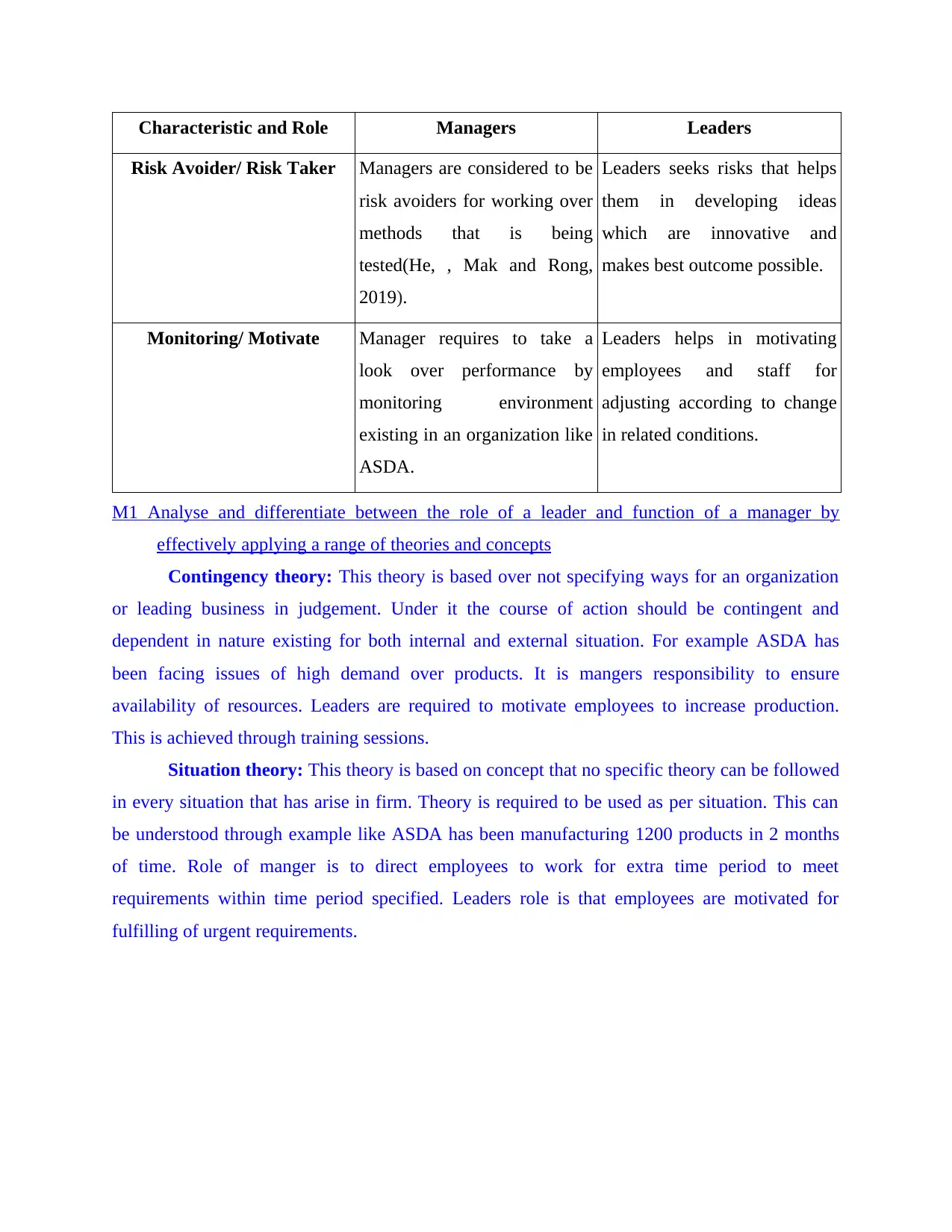
Characteristic and Role Managers Leaders
Risk Avoider/ Risk Taker Managers are considered to be
risk avoiders for working over
methods that is being
tested(He, , Mak and Rong,
2019).
Leaders seeks risks that helps
them in developing ideas
which are innovative and
makes best outcome possible.
Monitoring/ Motivate Manager requires to take a
look over performance by
monitoring environment
existing in an organization like
ASDA.
Leaders helps in motivating
employees and staff for
adjusting according to change
in related conditions.
M1 Analyse and differentiate between the role of a leader and function of a manager by
effectively applying a range of theories and concepts
Contingency theory: This theory is based over not specifying ways for an organization
or leading business in judgement. Under it the course of action should be contingent and
dependent in nature existing for both internal and external situation. For example ASDA has
been facing issues of high demand over products. It is mangers responsibility to ensure
availability of resources. Leaders are required to motivate employees to increase production.
This is achieved through training sessions.
Situation theory: This theory is based on concept that no specific theory can be followed
in every situation that has arise in firm. Theory is required to be used as per situation. This can
be understood through example like ASDA has been manufacturing 1200 products in 2 months
of time. Role of manger is to direct employees to work for extra time period to meet
requirements within time period specified. Leaders role is that employees are motivated for
fulfilling of urgent requirements.
Risk Avoider/ Risk Taker Managers are considered to be
risk avoiders for working over
methods that is being
tested(He, , Mak and Rong,
2019).
Leaders seeks risks that helps
them in developing ideas
which are innovative and
makes best outcome possible.
Monitoring/ Motivate Manager requires to take a
look over performance by
monitoring environment
existing in an organization like
ASDA.
Leaders helps in motivating
employees and staff for
adjusting according to change
in related conditions.
M1 Analyse and differentiate between the role of a leader and function of a manager by
effectively applying a range of theories and concepts
Contingency theory: This theory is based over not specifying ways for an organization
or leading business in judgement. Under it the course of action should be contingent and
dependent in nature existing for both internal and external situation. For example ASDA has
been facing issues of high demand over products. It is mangers responsibility to ensure
availability of resources. Leaders are required to motivate employees to increase production.
This is achieved through training sessions.
Situation theory: This theory is based on concept that no specific theory can be followed
in every situation that has arise in firm. Theory is required to be used as per situation. This can
be understood through example like ASDA has been manufacturing 1200 products in 2 months
of time. Role of manger is to direct employees to work for extra time period to meet
requirements within time period specified. Leaders role is that employees are motivated for
fulfilling of urgent requirements.
⊘ This is a preview!⊘
Do you want full access?
Subscribe today to unlock all pages.

Trusted by 1+ million students worldwide
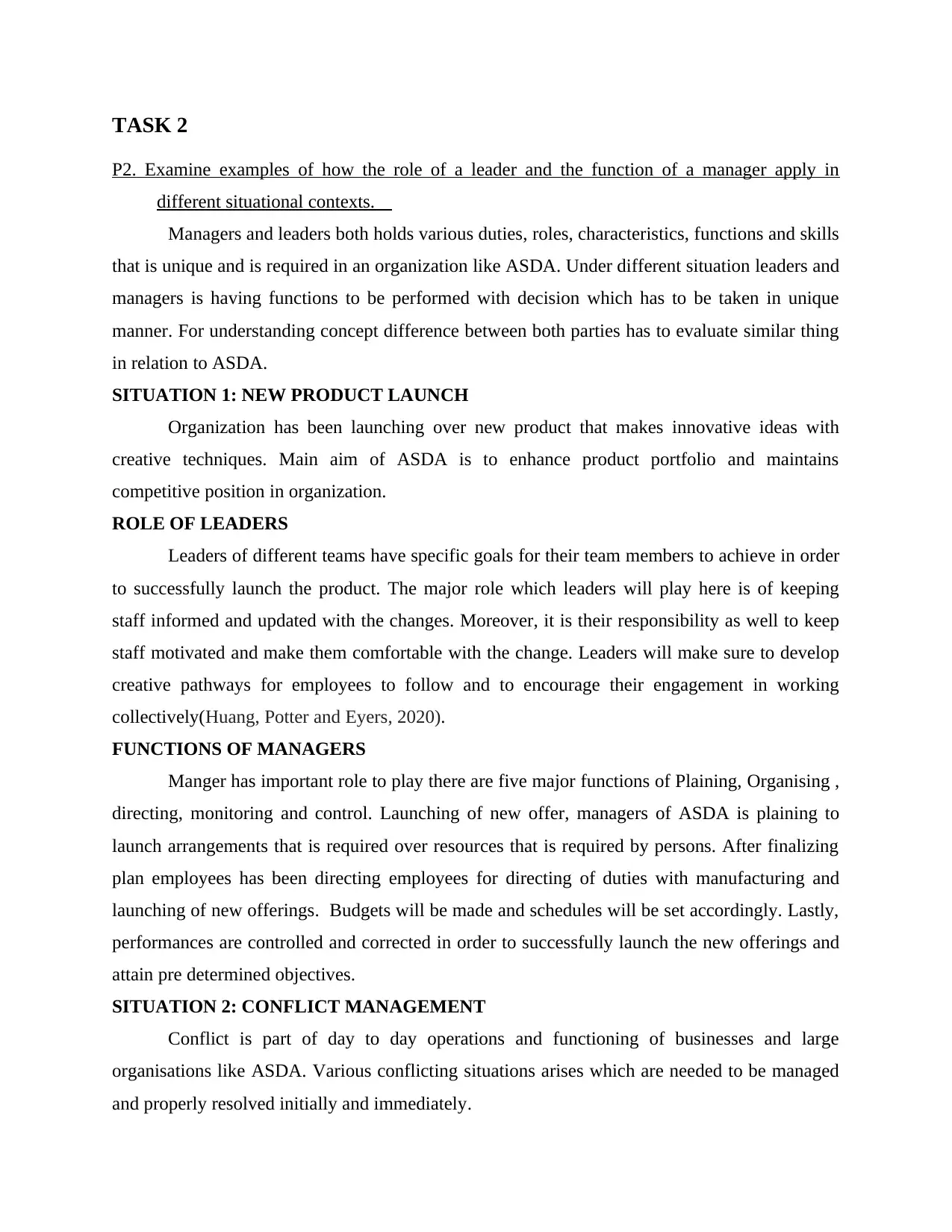
TASK 2
P2. Examine examples of how the role of a leader and the function of a manager apply in
different situational contexts.
Managers and leaders both holds various duties, roles, characteristics, functions and skills
that is unique and is required in an organization like ASDA. Under different situation leaders and
managers is having functions to be performed with decision which has to be taken in unique
manner. For understanding concept difference between both parties has to evaluate similar thing
in relation to ASDA.
SITUATION 1: NEW PRODUCT LAUNCH
Organization has been launching over new product that makes innovative ideas with
creative techniques. Main aim of ASDA is to enhance product portfolio and maintains
competitive position in organization.
ROLE OF LEADERS
Leaders of different teams have specific goals for their team members to achieve in order
to successfully launch the product. The major role which leaders will play here is of keeping
staff informed and updated with the changes. Moreover, it is their responsibility as well to keep
staff motivated and make them comfortable with the change. Leaders will make sure to develop
creative pathways for employees to follow and to encourage their engagement in working
collectively(Huang, Potter and Eyers, 2020).
FUNCTIONS OF MANAGERS
Manger has important role to play there are five major functions of Plaining, Organising ,
directing, monitoring and control. Launching of new offer, managers of ASDA is plaining to
launch arrangements that is required over resources that is required by persons. After finalizing
plan employees has been directing employees for directing of duties with manufacturing and
launching of new offerings. Budgets will be made and schedules will be set accordingly. Lastly,
performances are controlled and corrected in order to successfully launch the new offerings and
attain pre determined objectives.
SITUATION 2: CONFLICT MANAGEMENT
Conflict is part of day to day operations and functioning of businesses and large
organisations like ASDA. Various conflicting situations arises which are needed to be managed
and properly resolved initially and immediately.
P2. Examine examples of how the role of a leader and the function of a manager apply in
different situational contexts.
Managers and leaders both holds various duties, roles, characteristics, functions and skills
that is unique and is required in an organization like ASDA. Under different situation leaders and
managers is having functions to be performed with decision which has to be taken in unique
manner. For understanding concept difference between both parties has to evaluate similar thing
in relation to ASDA.
SITUATION 1: NEW PRODUCT LAUNCH
Organization has been launching over new product that makes innovative ideas with
creative techniques. Main aim of ASDA is to enhance product portfolio and maintains
competitive position in organization.
ROLE OF LEADERS
Leaders of different teams have specific goals for their team members to achieve in order
to successfully launch the product. The major role which leaders will play here is of keeping
staff informed and updated with the changes. Moreover, it is their responsibility as well to keep
staff motivated and make them comfortable with the change. Leaders will make sure to develop
creative pathways for employees to follow and to encourage their engagement in working
collectively(Huang, Potter and Eyers, 2020).
FUNCTIONS OF MANAGERS
Manger has important role to play there are five major functions of Plaining, Organising ,
directing, monitoring and control. Launching of new offer, managers of ASDA is plaining to
launch arrangements that is required over resources that is required by persons. After finalizing
plan employees has been directing employees for directing of duties with manufacturing and
launching of new offerings. Budgets will be made and schedules will be set accordingly. Lastly,
performances are controlled and corrected in order to successfully launch the new offerings and
attain pre determined objectives.
SITUATION 2: CONFLICT MANAGEMENT
Conflict is part of day to day operations and functioning of businesses and large
organisations like ASDA. Various conflicting situations arises which are needed to be managed
and properly resolved initially and immediately.
Paraphrase This Document
Need a fresh take? Get an instant paraphrase of this document with our AI Paraphraser
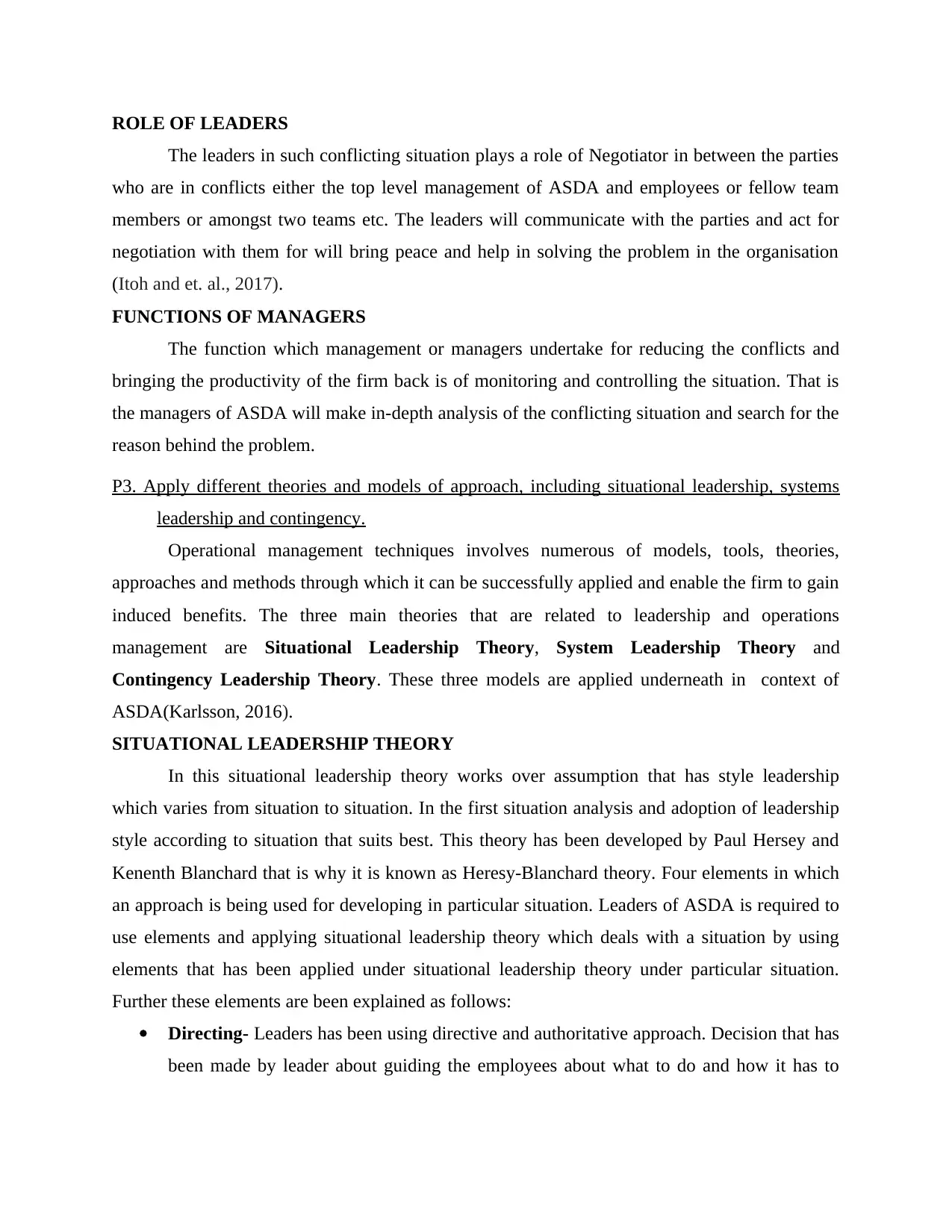
ROLE OF LEADERS
The leaders in such conflicting situation plays a role of Negotiator in between the parties
who are in conflicts either the top level management of ASDA and employees or fellow team
members or amongst two teams etc. The leaders will communicate with the parties and act for
negotiation with them for will bring peace and help in solving the problem in the organisation
(Itoh and et. al., 2017).
FUNCTIONS OF MANAGERS
The function which management or managers undertake for reducing the conflicts and
bringing the productivity of the firm back is of monitoring and controlling the situation. That is
the managers of ASDA will make in-depth analysis of the conflicting situation and search for the
reason behind the problem.
P3. Apply different theories and models of approach, including situational leadership, systems
leadership and contingency.
Operational management techniques involves numerous of models, tools, theories,
approaches and methods through which it can be successfully applied and enable the firm to gain
induced benefits. The three main theories that are related to leadership and operations
management are Situational Leadership Theory, System Leadership Theory and
Contingency Leadership Theory. These three models are applied underneath in context of
ASDA(Karlsson, 2016).
SITUATIONAL LEADERSHIP THEORY
In this situational leadership theory works over assumption that has style leadership
which varies from situation to situation. In the first situation analysis and adoption of leadership
style according to situation that suits best. This theory has been developed by Paul Hersey and
Kenenth Blanchard that is why it is known as Heresy-Blanchard theory. Four elements in which
an approach is being used for developing in particular situation. Leaders of ASDA is required to
use elements and applying situational leadership theory which deals with a situation by using
elements that has been applied under situational leadership theory under particular situation.
Further these elements are been explained as follows:
Directing- Leaders has been using directive and authoritative approach. Decision that has
been made by leader about guiding the employees about what to do and how it has to
The leaders in such conflicting situation plays a role of Negotiator in between the parties
who are in conflicts either the top level management of ASDA and employees or fellow team
members or amongst two teams etc. The leaders will communicate with the parties and act for
negotiation with them for will bring peace and help in solving the problem in the organisation
(Itoh and et. al., 2017).
FUNCTIONS OF MANAGERS
The function which management or managers undertake for reducing the conflicts and
bringing the productivity of the firm back is of monitoring and controlling the situation. That is
the managers of ASDA will make in-depth analysis of the conflicting situation and search for the
reason behind the problem.
P3. Apply different theories and models of approach, including situational leadership, systems
leadership and contingency.
Operational management techniques involves numerous of models, tools, theories,
approaches and methods through which it can be successfully applied and enable the firm to gain
induced benefits. The three main theories that are related to leadership and operations
management are Situational Leadership Theory, System Leadership Theory and
Contingency Leadership Theory. These three models are applied underneath in context of
ASDA(Karlsson, 2016).
SITUATIONAL LEADERSHIP THEORY
In this situational leadership theory works over assumption that has style leadership
which varies from situation to situation. In the first situation analysis and adoption of leadership
style according to situation that suits best. This theory has been developed by Paul Hersey and
Kenenth Blanchard that is why it is known as Heresy-Blanchard theory. Four elements in which
an approach is being used for developing in particular situation. Leaders of ASDA is required to
use elements and applying situational leadership theory which deals with a situation by using
elements that has been applied under situational leadership theory under particular situation.
Further these elements are been explained as follows:
Directing- Leaders has been using directive and authoritative approach. Decision that has
been made by leader about guiding the employees about what to do and how it has to
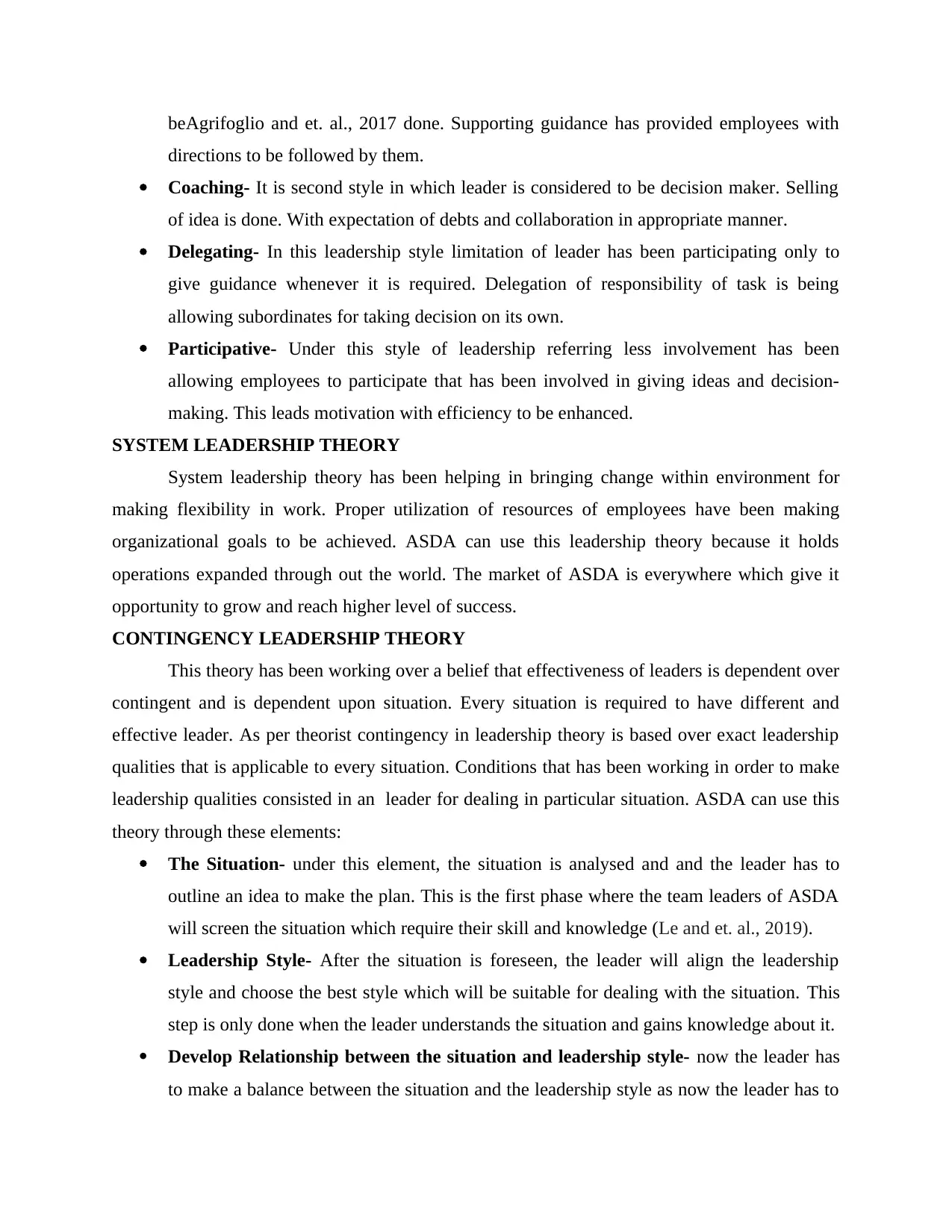
beAgrifoglio and et. al., 2017 done. Supporting guidance has provided employees with
directions to be followed by them.
Coaching- It is second style in which leader is considered to be decision maker. Selling
of idea is done. With expectation of debts and collaboration in appropriate manner.
Delegating- In this leadership style limitation of leader has been participating only to
give guidance whenever it is required. Delegation of responsibility of task is being
allowing subordinates for taking decision on its own.
Participative- Under this style of leadership referring less involvement has been
allowing employees to participate that has been involved in giving ideas and decision-
making. This leads motivation with efficiency to be enhanced.
SYSTEM LEADERSHIP THEORY
System leadership theory has been helping in bringing change within environment for
making flexibility in work. Proper utilization of resources of employees have been making
organizational goals to be achieved. ASDA can use this leadership theory because it holds
operations expanded through out the world. The market of ASDA is everywhere which give it
opportunity to grow and reach higher level of success.
CONTINGENCY LEADERSHIP THEORY
This theory has been working over a belief that effectiveness of leaders is dependent over
contingent and is dependent upon situation. Every situation is required to have different and
effective leader. As per theorist contingency in leadership theory is based over exact leadership
qualities that is applicable to every situation. Conditions that has been working in order to make
leadership qualities consisted in an leader for dealing in particular situation. ASDA can use this
theory through these elements:
The Situation- under this element, the situation is analysed and and the leader has to
outline an idea to make the plan. This is the first phase where the team leaders of ASDA
will screen the situation which require their skill and knowledge (Le and et. al., 2019).
Leadership Style- After the situation is foreseen, the leader will align the leadership
style and choose the best style which will be suitable for dealing with the situation. This
step is only done when the leader understands the situation and gains knowledge about it.
Develop Relationship between the situation and leadership style- now the leader has
to make a balance between the situation and the leadership style as now the leader has to
directions to be followed by them.
Coaching- It is second style in which leader is considered to be decision maker. Selling
of idea is done. With expectation of debts and collaboration in appropriate manner.
Delegating- In this leadership style limitation of leader has been participating only to
give guidance whenever it is required. Delegation of responsibility of task is being
allowing subordinates for taking decision on its own.
Participative- Under this style of leadership referring less involvement has been
allowing employees to participate that has been involved in giving ideas and decision-
making. This leads motivation with efficiency to be enhanced.
SYSTEM LEADERSHIP THEORY
System leadership theory has been helping in bringing change within environment for
making flexibility in work. Proper utilization of resources of employees have been making
organizational goals to be achieved. ASDA can use this leadership theory because it holds
operations expanded through out the world. The market of ASDA is everywhere which give it
opportunity to grow and reach higher level of success.
CONTINGENCY LEADERSHIP THEORY
This theory has been working over a belief that effectiveness of leaders is dependent over
contingent and is dependent upon situation. Every situation is required to have different and
effective leader. As per theorist contingency in leadership theory is based over exact leadership
qualities that is applicable to every situation. Conditions that has been working in order to make
leadership qualities consisted in an leader for dealing in particular situation. ASDA can use this
theory through these elements:
The Situation- under this element, the situation is analysed and and the leader has to
outline an idea to make the plan. This is the first phase where the team leaders of ASDA
will screen the situation which require their skill and knowledge (Le and et. al., 2019).
Leadership Style- After the situation is foreseen, the leader will align the leadership
style and choose the best style which will be suitable for dealing with the situation. This
step is only done when the leader understands the situation and gains knowledge about it.
Develop Relationship between the situation and leadership style- now the leader has
to make a balance between the situation and the leadership style as now the leader has to
⊘ This is a preview!⊘
Do you want full access?
Subscribe today to unlock all pages.

Trusted by 1+ million students worldwide
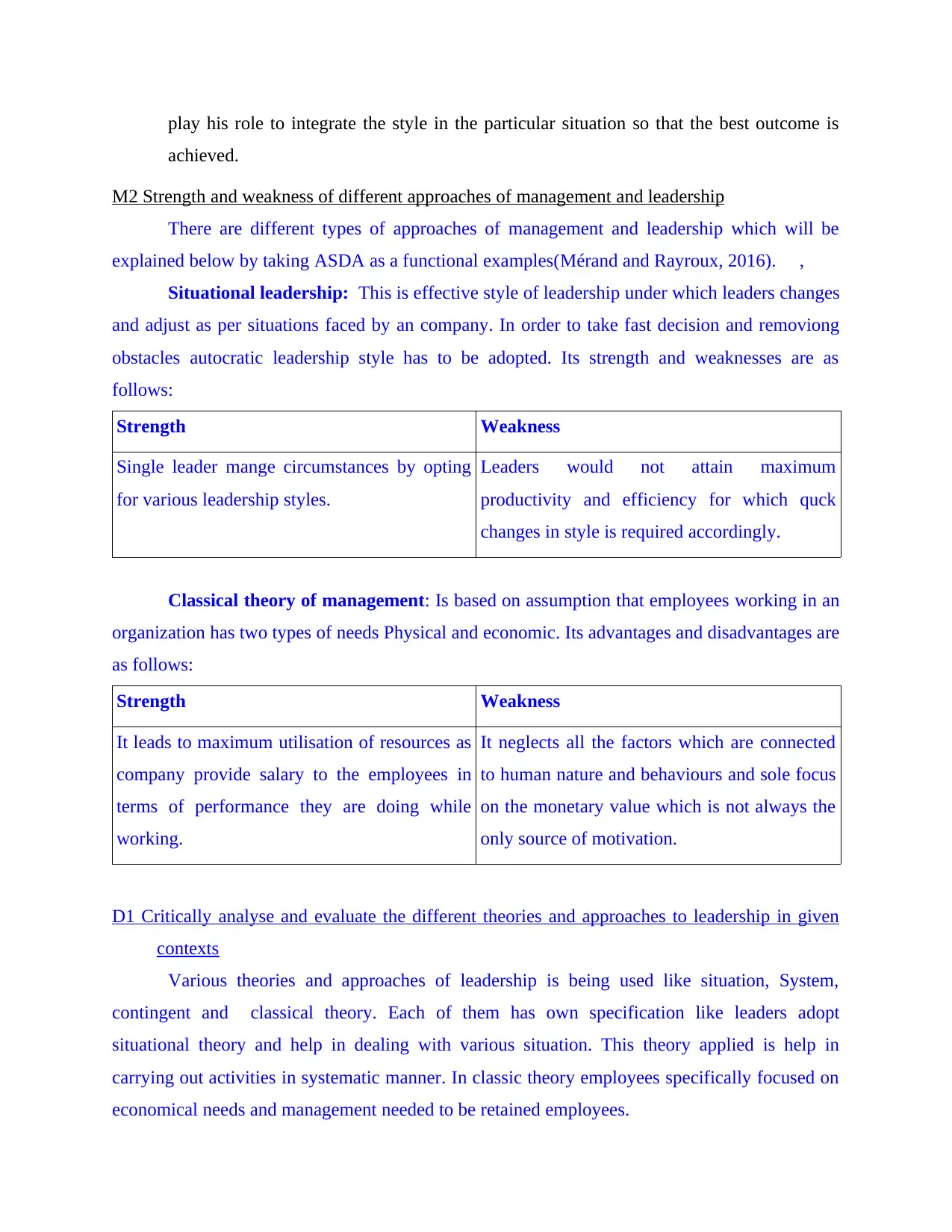
play his role to integrate the style in the particular situation so that the best outcome is
achieved.
M2 Strength and weakness of different approaches of management and leadership
There are different types of approaches of management and leadership which will be
explained below by taking ASDA as a functional examples(Mérand and Rayroux, 2016). ,
Situational leadership: This is effective style of leadership under which leaders changes
and adjust as per situations faced by an company. In order to take fast decision and removiong
obstacles autocratic leadership style has to be adopted. Its strength and weaknesses are as
follows:
Strength Weakness
Single leader mange circumstances by opting
for various leadership styles.
Leaders would not attain maximum
productivity and efficiency for which quck
changes in style is required accordingly.
Classical theory of management: Is based on assumption that employees working in an
organization has two types of needs Physical and economic. Its advantages and disadvantages are
as follows:
Strength Weakness
It leads to maximum utilisation of resources as
company provide salary to the employees in
terms of performance they are doing while
working.
It neglects all the factors which are connected
to human nature and behaviours and sole focus
on the monetary value which is not always the
only source of motivation.
D1 Critically analyse and evaluate the different theories and approaches to leadership in given
contexts
Various theories and approaches of leadership is being used like situation, System,
contingent and classical theory. Each of them has own specification like leaders adopt
situational theory and help in dealing with various situation. This theory applied is help in
carrying out activities in systematic manner. In classic theory employees specifically focused on
economical needs and management needed to be retained employees.
achieved.
M2 Strength and weakness of different approaches of management and leadership
There are different types of approaches of management and leadership which will be
explained below by taking ASDA as a functional examples(Mérand and Rayroux, 2016). ,
Situational leadership: This is effective style of leadership under which leaders changes
and adjust as per situations faced by an company. In order to take fast decision and removiong
obstacles autocratic leadership style has to be adopted. Its strength and weaknesses are as
follows:
Strength Weakness
Single leader mange circumstances by opting
for various leadership styles.
Leaders would not attain maximum
productivity and efficiency for which quck
changes in style is required accordingly.
Classical theory of management: Is based on assumption that employees working in an
organization has two types of needs Physical and economic. Its advantages and disadvantages are
as follows:
Strength Weakness
It leads to maximum utilisation of resources as
company provide salary to the employees in
terms of performance they are doing while
working.
It neglects all the factors which are connected
to human nature and behaviours and sole focus
on the monetary value which is not always the
only source of motivation.
D1 Critically analyse and evaluate the different theories and approaches to leadership in given
contexts
Various theories and approaches of leadership is being used like situation, System,
contingent and classical theory. Each of them has own specification like leaders adopt
situational theory and help in dealing with various situation. This theory applied is help in
carrying out activities in systematic manner. In classic theory employees specifically focused on
economical needs and management needed to be retained employees.
Paraphrase This Document
Need a fresh take? Get an instant paraphrase of this document with our AI Paraphraser
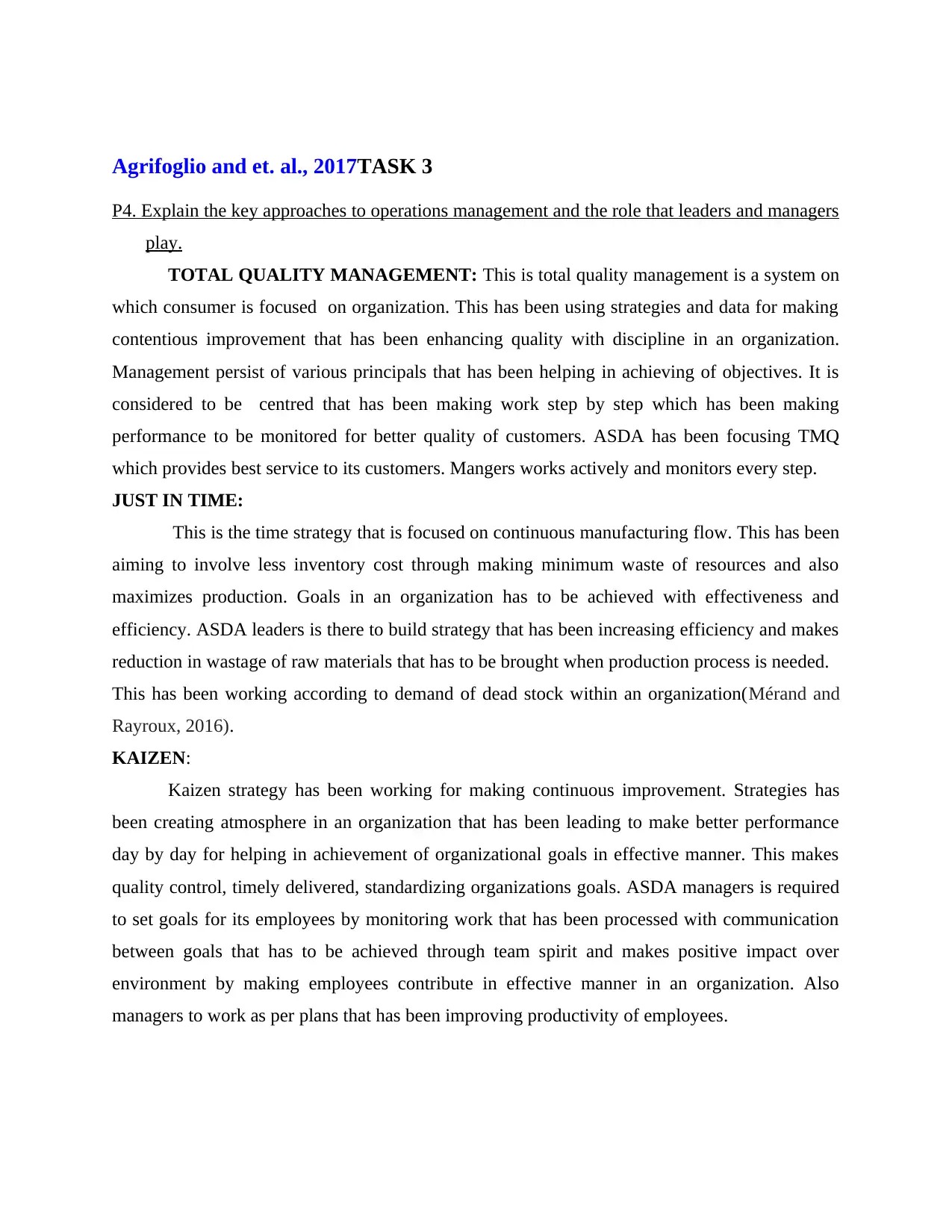
Agrifoglio and et. al., 2017TASK 3
P4. Explain the key approaches to operations management and the role that leaders and managers
play.
TOTAL QUALITY MANAGEMENT: This is total quality management is a system on
which consumer is focused on organization. This has been using strategies and data for making
contentious improvement that has been enhancing quality with discipline in an organization.
Management persist of various principals that has been helping in achieving of objectives. It is
considered to be centred that has been making work step by step which has been making
performance to be monitored for better quality of customers. ASDA has been focusing TMQ
which provides best service to its customers. Mangers works actively and monitors every step.
JUST IN TIME:
This is the time strategy that is focused on continuous manufacturing flow. This has been
aiming to involve less inventory cost through making minimum waste of resources and also
maximizes production. Goals in an organization has to be achieved with effectiveness and
efficiency. ASDA leaders is there to build strategy that has been increasing efficiency and makes
reduction in wastage of raw materials that has to be brought when production process is needed.
This has been working according to demand of dead stock within an organization(Mérand and
Rayroux, 2016).
KAIZEN:
Kaizen strategy has been working for making continuous improvement. Strategies has
been creating atmosphere in an organization that has been leading to make better performance
day by day for helping in achievement of organizational goals in effective manner. This makes
quality control, timely delivered, standardizing organizations goals. ASDA managers is required
to set goals for its employees by monitoring work that has been processed with communication
between goals that has to be achieved through team spirit and makes positive impact over
environment by making employees contribute in effective manner in an organization. Also
managers to work as per plans that has been improving productivity of employees.
P4. Explain the key approaches to operations management and the role that leaders and managers
play.
TOTAL QUALITY MANAGEMENT: This is total quality management is a system on
which consumer is focused on organization. This has been using strategies and data for making
contentious improvement that has been enhancing quality with discipline in an organization.
Management persist of various principals that has been helping in achieving of objectives. It is
considered to be centred that has been making work step by step which has been making
performance to be monitored for better quality of customers. ASDA has been focusing TMQ
which provides best service to its customers. Mangers works actively and monitors every step.
JUST IN TIME:
This is the time strategy that is focused on continuous manufacturing flow. This has been
aiming to involve less inventory cost through making minimum waste of resources and also
maximizes production. Goals in an organization has to be achieved with effectiveness and
efficiency. ASDA leaders is there to build strategy that has been increasing efficiency and makes
reduction in wastage of raw materials that has to be brought when production process is needed.
This has been working according to demand of dead stock within an organization(Mérand and
Rayroux, 2016).
KAIZEN:
Kaizen strategy has been working for making continuous improvement. Strategies has
been creating atmosphere in an organization that has been leading to make better performance
day by day for helping in achievement of organizational goals in effective manner. This makes
quality control, timely delivered, standardizing organizations goals. ASDA managers is required
to set goals for its employees by monitoring work that has been processed with communication
between goals that has to be achieved through team spirit and makes positive impact over
environment by making employees contribute in effective manner in an organization. Also
managers to work as per plans that has been improving productivity of employees.
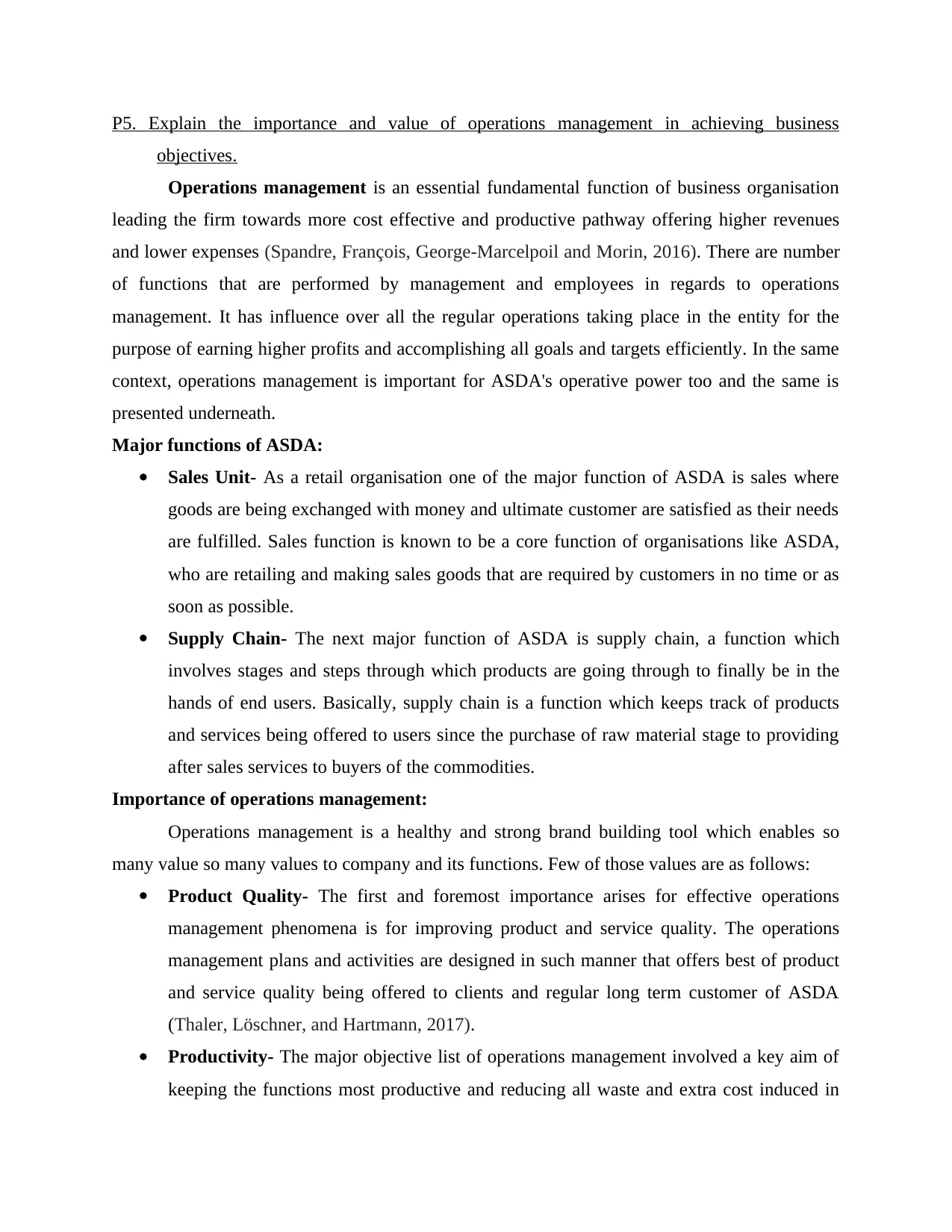
P5. Explain the importance and value of operations management in achieving business
objectives.
Operations management is an essential fundamental function of business organisation
leading the firm towards more cost effective and productive pathway offering higher revenues
and lower expenses (Spandre, François, George-Marcelpoil and Morin, 2016). There are number
of functions that are performed by management and employees in regards to operations
management. It has influence over all the regular operations taking place in the entity for the
purpose of earning higher profits and accomplishing all goals and targets efficiently. In the same
context, operations management is important for ASDA's operative power too and the same is
presented underneath.
Major functions of ASDA:
Sales Unit- As a retail organisation one of the major function of ASDA is sales where
goods are being exchanged with money and ultimate customer are satisfied as their needs
are fulfilled. Sales function is known to be a core function of organisations like ASDA,
who are retailing and making sales goods that are required by customers in no time or as
soon as possible.
Supply Chain- The next major function of ASDA is supply chain, a function which
involves stages and steps through which products are going through to finally be in the
hands of end users. Basically, supply chain is a function which keeps track of products
and services being offered to users since the purchase of raw material stage to providing
after sales services to buyers of the commodities.
Importance of operations management:
Operations management is a healthy and strong brand building tool which enables so
many value so many values to company and its functions. Few of those values are as follows:
Product Quality- The first and foremost importance arises for effective operations
management phenomena is for improving product and service quality. The operations
management plans and activities are designed in such manner that offers best of product
and service quality being offered to clients and regular long term customer of ASDA
(Thaler, Löschner, and Hartmann, 2017).
Productivity- The major objective list of operations management involved a key aim of
keeping the functions most productive and reducing all waste and extra cost induced in
objectives.
Operations management is an essential fundamental function of business organisation
leading the firm towards more cost effective and productive pathway offering higher revenues
and lower expenses (Spandre, François, George-Marcelpoil and Morin, 2016). There are number
of functions that are performed by management and employees in regards to operations
management. It has influence over all the regular operations taking place in the entity for the
purpose of earning higher profits and accomplishing all goals and targets efficiently. In the same
context, operations management is important for ASDA's operative power too and the same is
presented underneath.
Major functions of ASDA:
Sales Unit- As a retail organisation one of the major function of ASDA is sales where
goods are being exchanged with money and ultimate customer are satisfied as their needs
are fulfilled. Sales function is known to be a core function of organisations like ASDA,
who are retailing and making sales goods that are required by customers in no time or as
soon as possible.
Supply Chain- The next major function of ASDA is supply chain, a function which
involves stages and steps through which products are going through to finally be in the
hands of end users. Basically, supply chain is a function which keeps track of products
and services being offered to users since the purchase of raw material stage to providing
after sales services to buyers of the commodities.
Importance of operations management:
Operations management is a healthy and strong brand building tool which enables so
many value so many values to company and its functions. Few of those values are as follows:
Product Quality- The first and foremost importance arises for effective operations
management phenomena is for improving product and service quality. The operations
management plans and activities are designed in such manner that offers best of product
and service quality being offered to clients and regular long term customer of ASDA
(Thaler, Löschner, and Hartmann, 2017).
Productivity- The major objective list of operations management involved a key aim of
keeping the functions most productive and reducing all waste and extra cost induced in
⊘ This is a preview!⊘
Do you want full access?
Subscribe today to unlock all pages.

Trusted by 1+ million students worldwide
1 out of 17
Related Documents
Your All-in-One AI-Powered Toolkit for Academic Success.
+13062052269
info@desklib.com
Available 24*7 on WhatsApp / Email
![[object Object]](/_next/static/media/star-bottom.7253800d.svg)
Unlock your academic potential
Copyright © 2020–2025 A2Z Services. All Rights Reserved. Developed and managed by ZUCOL.




